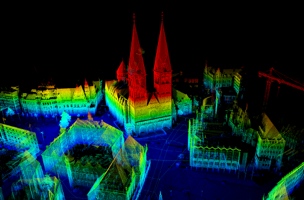My last post seemed to strike a nerve, with more reposts and retweets than I’ve seen in a while! In fact, Gene Roe opened the entire topic up for debate on LiDAR News before I knew what was happening… I stand by my position that data capture is becoming a commodity. It was brought to my attention last week that, while I alluded to price changes being imminent, I did not actually address the fact that what may have to change is not only the price but also the pricing model(s) that we have been using to date.
For many in the service provider realm, day rates have been the standard pricing model. When you look back a few years it makes sense. It was not so long ago that a world-class scanner was one that could collect 4000-5000 points per second. Given that the current standard is just over 1 million points per second, a scan that used to take over an hour now takes less than 10 minutes. Those day rates and 4 hour minimums were based upon the fact that at one time it took 2 hours of your day to set up and tear down; regardless of the number of scans. Today’s scanners also save logistics time by losing the external car batteries, dramatically reducing the platform and case sizes, switching to onboard vs. the old laptop based control, wireless vs. cable connections, etc. Lastly, more clients now use the registered point cloud as opposed to needing everything to be modeled. The combination of all of these facts means that there are a lot of prospective clients out there that only need an hour or two of your time and as a result have no interest in paying for eight hours of it! When these clients come calling, do you have a pricing model that converts them to customers?
As with most emerging markets there seems to be a lot of different ways of addressing the pricing issue. Perhaps, given the variety of scanning platforms and use cases, there will never be a single best case. I have a particularly difficult time addressing customer quotes when scope changes alter my choice of collection equipment. Trying to explain to a client the differences between a sub-millimeter accurate hand scanner (that they initially required due to some insane accuracy specification which is later determined to have been pulled out of thin air) versus a tripod-based unit with sub-centimeter accuracy that costs double even though it is less accurate, and why the hourly rates are this and that but that the total time on site will vary, and blah, blah, blah… is honest, it’s accurate, but it’s confusing and ultimately not very helpful.
So, what are some things that we can do that are helpful?
- Turn-key Pricing – The advantage here is that you avoid the hourly rate issue and can actually price according to the perceived value or whatever the market will bear. If you become more efficient, then you make more money. If the scope changes then you set a new price. This also lets you account for the differences in client demands, because even if the time to complete the work is the same between two clients, the amount of time each demands may be very different.
- Special Rate Zones – The idea here is to give an hourly rate, but with a caveat. It allows you to address a need without letting go of your current pricing model, which may work very well in other markets. We (SmartGeoMetrics) used distance as a differentiator. Within 60 miles of the office, no travel charges and you were billed actual hours worked at a set rate per hour. You could do the same thing with other differentiators (particular industries, particular clients, particular hardware packages etc.)
- Hourly Rates at Home – With some types of scanning you don’t have to go to the object as it is small enough to come to you. This is especially applicable to those of us with hand scanners. These are easy to list as hourly rates, since the customer can ship the object to your office with a return label. If you are worried about being snowed under with small objects, set a minimum fee to help cover the administration time necessary for billing (or set up online payment).
- Workin’ the Subs – When a client is looking at your service as a commodity, he is probably doing the same thing with other aspects of the project as well. Take an architect for example. He/She may be using you for data collection, but probably also outsourcing structural design to an engineering firm, HVAC design to the company performing the HVAC install, lighting design to an interior design firm, exterior metal cladding to a specialist that only works with metal architecture systems, and so on. These subcontractors may not pay you or even sign off on your deliverables but they are the professionals that will be working with your data. Get to know them and make sure that you are delivering what they need so that they want you to deliver their data to them any time they have a choice. Dealing directly technician to technician can often save time for both of you. With a good line of communication and known workflows you’ll find those subs requesting you on other projects. Nothing makes small invoices more profitable than having them delivered to you without any marketing costs on your end.






